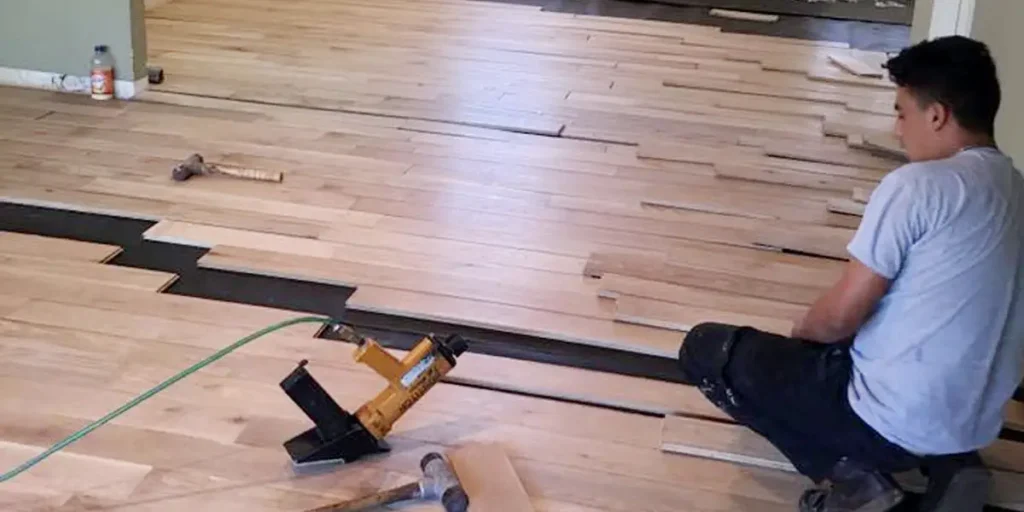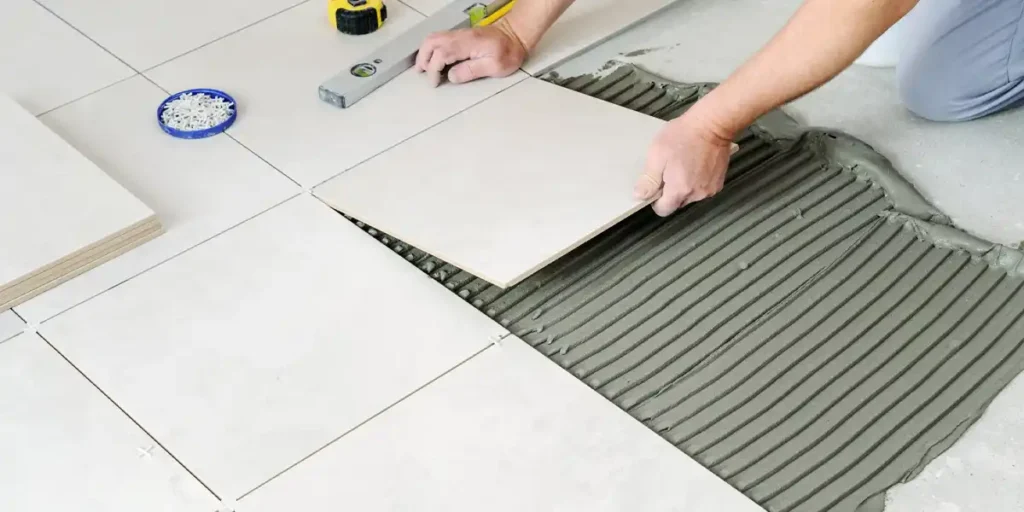Flooring changes the way a space looks and feels. It’s the foundation you walk on daily, and it affects comfort, safety, and energy use. Whether you’re redoing one room or the entire property, your flooring installation can make or break the impact of the upgrade.
Think about stepping into a living room with perfectly aligned hardwood that brings out the natural light. Or imagine a kitchen with vinyl flooring that resists spills and is easy to clean. When installed professionally, floors can deliver these benefits without the stress of mistakes or wasted materials.
This guide shows why professional flooring installation matters, explores different types of flooring and explains how hiring experts makes a difference.
Why Professional Flooring Installation Matters
Installing flooring might seem simple, but mistakes can lead to uneven surfaces, damage, or even safety risks. Professionals bring the tools, skills, and experience to ensure the job is done right. The benefits far outweigh the initial costs.
Ensuring Durability and Longevity
The durability of your floors depends on how they’re installed. Materials like hardwood, vinyl, and tile need proper preparation and placement to hold up over time. Experts prepare subfloors by cleaning, leveling, and drying them to prevent future issues like cracking or moisture damage.
For example, hardwood expands and contracts with temperature changes. Without proper spacing, it can buckle or leave gaps. Similarly, tiles need precise grout lines and strong adhesive to stay secure. Professional installation ensures your floors last longer and perform better.
The Role of Precision in Aesthetics
Precision makes floors look polished. Small mistakes in measurements or alignment can ruin the overall look of a room. Professionals cut materials with advanced tools to fit perfectly, ensuring seamless edges and smooth transitions. This is especially important for intricate tile patterns or consistent laminate plank spacing.
Accurate installation also minimizes waste. By measuring and cutting precisely, professionals reduce material loss, saving you money.
Types of Flooring for Different Needs
Choosing the right flooring depends on how you use the space, your budget, and the look you want. Here are some common options and their benefits.
Hardwood: A Timeless Choice
Hardwood floors add value and elegance to a home. They’re ideal for living rooms, bedrooms, and dining areas. Options like oak, maple, and cherry offer unique grain patterns and tones.
Professional installation is key. Experts acclimate the wood to the room’s humidity before laying it down, reducing the risk of expansion or contraction. They also ensure planks fit together perfectly for a smooth, uniform surface.
Laminate and Vinyl: Affordable Alternatives
Laminate and vinyl are great budget-friendly options. Laminate mimics wood or stone but is easier to maintain. Vinyl resists moisture, making it a good choice for kitchens, bathrooms, and laundry rooms.
Experts ensure these materials perform well by securing seams and edges to block water from getting underneath. They also address subfloor imperfections that could cause uneven surfaces or wear.
Tile Flooring: For High-Traffic Areas
Tile is durable and versatile, making it perfect for entryways, kitchens, and bathrooms. It resists moisture and stains, and it’s easy to clean. Ceramic, porcelain, and natural stone tiles come in a wide range of styles to fit any design.
Professional installation ensures tiles are level, grout lines are even, and adhesives hold everything securely. This attention to detail keeps tiles from cracking or shifting over time, ensuring they remain both functional and stylish.
The Expert Flooring Installation Process
Understanding the flooring installation process helps you see the value of hiring professionals. Here’s what happens during a professional flooring installation:
Consultation and Assessment
Professionals assess your space and discuss your needs. They look at room dimensions, lighting, and usage to recommend the best flooring materials. This step includes identifying any unique challenges in the room, such as uneven surfaces or areas prone to moisture, and offering tailored solutions.
Professionals also help homeowners understand how different materials perform in specific conditions.
Preparation
They prepare the subfloor by cleaning, levelling, and addressing moisture issues. For some materials, they add underlayment to improve performance. Subfloor preparation ensures that the flooring material will adhere properly and stay durable over time.
It also prevents common problems like squeaky floors or uneven surfaces, which can occur if the base is not adequately prepared.
Material Acclimation
Materials like hardwood and laminate need to adjust to the room’s temperature and humidity. This step prevents problems like warping later.
Acclimation typically involves leaving the materials in the room for at least 48 hours to stabilize. Professionals monitor the conditions to ensure the materials are ready for installation.
Accurate Measurements and Cutting
Professionals take precise measurements to reduce waste and ensure alignment. They use tools to cut materials for a perfect fit, even in corners and edges.
This step minimizes gaps between planks or tiles, ensuring a clean and seamless appearance. Precise cutting also reduces the need for adjustments later, saving time and resources.
Installation
The method depends on the material. Hardwood is nailed or glued, tiles are adhered with mortar and grout, and laminate snaps into place.
Professionals make sure each piece is secure. They also handle challenging layouts, such as curved edges or intricate patterns, ensuring the final result meets the design vision.
Finishing Touches
They complete the job with steps like sealing, grouting, or trimming. These ensure the floor lasts and functions well.
For example, sealing hardwood floors protects them from moisture, while grout work on tiles prevents dirt accumulation and ensures stability. Professionals also add transitions between rooms to create a cohesive flow.
Cleanup
Professionals clean the area and make the floor ready for use. They also provide instructions for maintaining the flooring.
Proper cleanup removes debris and ensures no residue or tools are left behind, allowing homeowners to immediately enjoy their new floors.
Positive Effects of Expert Flooring Installation
Hiring experts to install your flooring gives you more than just good looks. A professional job makes your floors work better, feel better, and last longer.
When done right, flooring transforms your space into something functional and enjoyable. Let’s look at how expert installation connects to every part of your home experience.
Customized Subfloor Adjustments for Specific Needs
Every floor depends on a solid foundation to perform well. Professionals don’t just install flooring; they start by fixing what’s underneath. If the subfloor is uneven, they level it out. If moisture is an issue, they add barriers. If the floor needs extra support, they add insulation. These steps create the right base for your chosen flooring.
For example, tiles need a rigid subfloor to prevent cracking, while hardwood needs protection from moisture to stay intact. Without this preparation, your flooring won’t last as long or perform as it should.
Integration with Smart Home Systems
New floors don’t just look good, they can also work with modern technology. Professionals make sure your floors align with smart home features like underfloor heating.
For example, radiant heating beneath tiles keeps your home warm while lowering energy bills. When experts handle the installation, they ensure everything fits together smoothly, so your floors become part of a smarter, more efficient home.
Psychological Benefits of Professional Flooring
Floors affect how a space feels every day. When they’re smooth and even, they make a room feel organized and calm. This matters in homes, offices, and any space where people gather.
For example, warm-toned hardwood creates a welcoming vibe in living rooms, while bright tiles make bathrooms feel clean and open. Professional installation ensures these finishes enhance the atmosphere instead of causing distractions with uneven edges or misaligned patterns.
Optimized Safety for High-Risk Areas
Some parts of your home, like kitchens and bathrooms, need flooring that keeps everyone safe. Professionals help by installing slip-resistant surfaces and securing every edge. This reduces the risk of trips and falls.
For example, a properly installed floor in a bathroom can prevent water buildup and make it safer to walk. These small details create a safer space for everyone, especially in high-risk areas.
Long-Term Energy Efficiency
Floors do more than look good; they help keep your home comfortable. Materials like cork or insulated vinyl keep heat in during the winter and block drafts.
When professionals install your floors, they seal gaps and seams that let air escape. Over time, this keeps your energy bills lower and your home’s temperature more stable.
Flexibility for Future Upgrades
Homes change over time, and your flooring should be able to change with them. Professional installation makes future upgrades easier.
For example, floating floors let you replace individual planks without tearing up the entire floor. This means you can refresh your space without a major renovation, saving both time and money.
Optimized Performance in Extreme Climates
Some areas experience extreme weather, and your floors need to handle those conditions. Professionals consider temperature and humidity when installing flooring.
For example, they might recommend engineered wood in humid areas because it resists warping better than solid wood. This planning keeps your floors stable no matter the climate.
Preservation of Structural Integrity
Floors carry the weight of everything in your home. If installed poorly, they can put extra stress on your home’s foundation.
Professionals distribute this weight evenly, protecting your home’s structure. This not only keeps your floors in good shape but also avoids expensive repairs to your foundation in the future.
Flooring Installation for Future-Proofing Your Home
Future-proofing your home means choosing floors that meet your needs now and can adjust to changes later. Expert installation ensures your floors remain valuable and functional as time goes on.
Preparing for Resale Value
The right flooring makes a home more attractive to buyers. People notice floors first, and high-quality materials installed properly make a strong impression. Hardwood floors, for example, are popular because they last long and fit any style. Laminate and tile floors also appeal to buyers who want something easy to care for. When professionals install these materials, they ensure the floors look great and hold up over time, which helps maintain or increase the value of your home.
Adaptable Flooring Solutions
Some flooring options make it easier to update a room without major work. Modular tiles and floating floors, for instance, allow you to replace only the parts that need fixing. Imagine swapping out a few damaged tiles instead of redoing an entire floor. This flexibility helps you keep your home up to date with less effort and cost, ensuring it stays functional and stylish as your needs or tastes change.
Addressing Accessibility in Flooring Design
Flooring plays a key role in creating spaces that everyone can use comfortably. Professionals look at the specific needs of a space and recommend materials that make movement easier for people using wheelchairs, walkers, or other aids. Smooth, level surfaces allow for easy navigation, while slip-resistant finishes add an extra layer of safety.
For homes with multiple levels, professionals can install ramps or transitions to help bridge height differences between rooms. These adjustments also make it more inclusive. Whether it’s widening entryways or ensuring floors are even, expert installation creates a home where everyone feels welcome and supported.
Consumer Misconceptions About Professional Flooring
Some consumers hesitate to hire professionals due to common misconceptions. Here are a few myths and the reality behind them:
“DIY Works Just as Well as Professionals”
DIY projects can save money upfront but often lead to errors. Uneven cuts or poor preparation can shorten the floor’s lifespan.
Professionals ensure accurate work that lasts longer. They also have access to tools and techniques that homeowners may not, which results in a higher-quality installation.
“Professional Installation Costs Too Much”
Hiring experts may seem expensive, but it saves money by preventing waste and future repairs. Proper installation also extends the floor’s life.
Professionals often work efficiently, reducing the time spent on the project and minimizing disruption to your home.
“All Installers Provide the Same Service”
Not all installers have the same skills or certifications. Research and reviews help you find qualified professionals who meet your needs. Experienced installers often have portfolios showcasing their work, which can help you assess their expertise.
“Any Flooring Works in Any Room”
Flooring must match the environment. Professionals consider moisture, temperature, and foot traffic to recommend the best materials for each space. For example, they may suggest waterproof vinyl for bathrooms or high-durability tiles for entryways. This ensures the flooring performs well under specific conditions.
“Installation Is Just Laying the Flooring Down”
Installation involves preparation, precise cutting, and attention to detail. These steps ensure the flooring lasts and performs as expected. Professionals also address details like ensuring transitions between rooms are smooth and aligning patterns or grains for a cohesive look.
How to Choose the Right Flooring Installation Service
Selecting the right flooring installation service is essential to achieving the best results. Here are some tips to guide your decision.
Checking Credentials and Experience
Research the company’s credentials and experience. Look for certifications or memberships in professional organizations that indicate a commitment to industry standards. Ask about their experience with specific flooring materials to ensure they have the expertise needed for your project.
Reading Reviews and Asking for Referrals
Customer reviews provide valuable insights into a company’s reliability and quality of work. Look for reviews that mention specific aspects of the installation process, such as timeliness, attention to detail, or problem-solving. Additionally, ask for referrals from friends or family who have had similar projects completed.
Comparing Estimates and Services
Obtain multiple estimates to compare costs and services. Ensure each estimate includes details such as subfloor preparation, material installation, and finishing touches. This transparency helps you make informed decisions and avoid hidden costs.
Wrapping it Up
Expert flooring installation transforms any space into a functional and visually appealing environment. Whether you choose hardwood, laminate, vinyl, or tile, professional installation ensures durability, safety, and long-term value. By hiring the right professionals, you gain peace of mind knowing that your flooring will serve its purpose for years to come.
Invest in expert flooring installation to enhance your home or business. A well-installed floor not only elevates the aesthetics of a space but also improves its functionality and value. Get in touch with Cardenas Flooring today and breathe new life into your home.
FAQs
1. How do I know which flooring material is best for my home?
The best flooring material depends on your lifestyle, budget, and the room’s purpose. For example, hardwood is ideal for living areas, while tile works well in bathrooms and kitchens due to its moisture resistance. A professional contractor can help you choose the right material based on these factors.
2. Why should I hire a professional for flooring installation?
Professional installers ensure the job is done correctly, preventing issues like uneven surfaces, gaps, or poor adhesion. They also bring the tools and expertise needed to handle different materials, saving you time, money, and stress in the long run.
3. Can I install new flooring over my existing floor?
It depends on the condition and type of your existing flooring. For example, laminate and vinyl can often be installed over certain floors, but damaged or uneven surfaces may require removal or subfloor preparation. A professional assessment is essential for the best results.
4. How long does flooring installation usually take?
The timeline varies based on the type of flooring, the size of the space, and the condition of the subfloor. For example, hardwood installation may take a few days, while laminate or vinyl can often be completed in a single day. Discussing the timeline with your contractor can give you a better estimate.
5. How can I maintain my new floors to ensure they last?
Proper maintenance depends on the material. Regular sweeping and occasional refinishing help keep hardwood in good condition. Tile floors benefit from routine cleaning and re-grouting when needed. A professional installer can provide specific care instructions for your chosen flooring.




